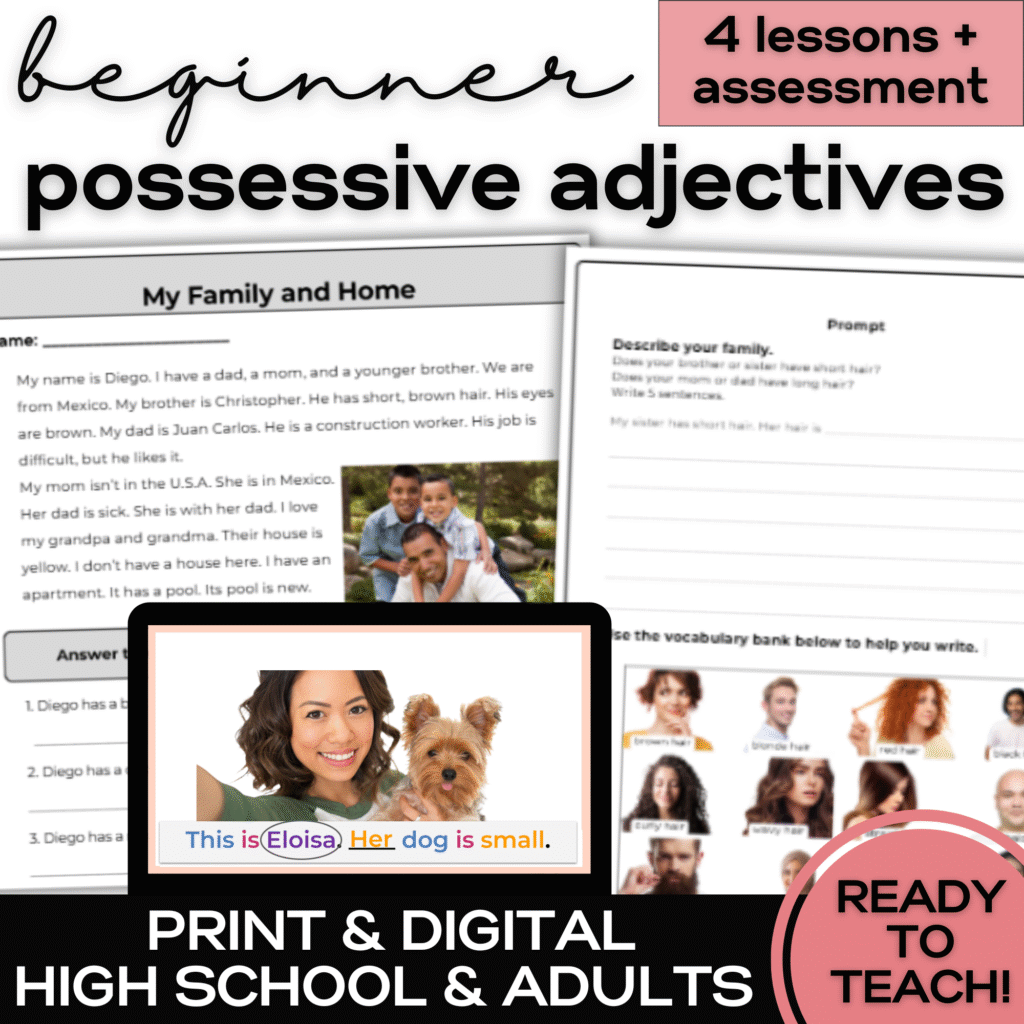As students begin to build strength with subject pronouns, they naturally expand into possessive adjectives. However, they often use them incorrectly. The problem is that focused practice is needed. My, your, his, her, their, and our require students to connect grammar to context.
Fix these 4 common possessive adjective mistakes with clear, effective ESL grammar strategies.
🚧 Mistake #1: Dropping the Possessive Adjective
Looks like: Student says, “He sister is a teacher.”
Why it happens: Students simply don’t know what the possessive adjectives are yet.
🛠️The fix: Introduce the grammar through context.
- Expose students to visuals first, and ask students to connect sentences with possessive adjectives to a picture. For example, students connect the sentence “His brother has glasses” to a picture of two brothers, one with glasses. Without getting into the grammar, students read his and connect it to a male.
- Ask students to write it in context while connecting the possessive back to the subject pronoun. For example, a worksheet might have a question like “I have a brother. _____ brother is tall.”
🚧 Mistake #2: Overusing My
Looks like: My mom is a teacher when the student is talking about someone else.
Why it happens: My becomes the default when students aren’t sure what to use next. They may not have enough practice with the other possessives.
🛠️The fix:
- Begin with input. Students should read a short text where possessive adjectives are used naturally. Use drop-in reading, so that students read aloud my, your, its, her, his, their, our in context. Finally, ask students to speak or write answers to questions using the text.
- Then, encourage students to listen for possessive adjectives in context, and then talk about other people’s families. That forces them to use the adjectives naturally.
🚧 Mistake #3: Mixing up Her and His
Looks like: His name is Jane.
Why it happens: Students from other cultures do not intuitively know what gender many of our names are. It seems simple to us that Jane is female, but why would a student from across the globe know that?
🛠️The fix:
- When possible, use images so students can see the gender of the subject or if the subject is singular or plural. Use names of students in your classroom when working with projectable class activities and worksheets.
- If your students already know job vocabulary, then this background vocabulary with images works great to help students get comfortable with his and her.
🚧 Mistake #4: Still NOT Using the Correct Possessive Adjective
Why it happens: Students may be overwhelmed. They may be focusing on new vocabulary more than on using the correct adjective.
🛠️The fix:
- Teach the possessive adjective with vocabulary that students already know. I have an introductory lesson with family member vocabulary that I teach before starting students on the grammar. If you don’t have time to teach new vocabulary, use what students already know, like objects in a classroom or items in a home.
After years of seeing similar errors repeat, I added in extra activities to create a robust Possessive Adjectives Unit that fixes these problems.
✅ Before teaching the grammar, I introduce family vocabulary. Flash cards included!
✅ I use visuals so students can connect gender and context to the correct adjectives.
✅ Students review subject pronouns and match them to their possessive adjectives.
✅ Through drop-in reading, students identify the possessive adjectives in context.
✅ Students listen for possessive adjectives in context to reinforce understanding.
✅ In the end, I personalize the concept. Students write about their families, listen to others, and share what they hear aloud.
✅ All slides, worksheets, readings, and activities are editable so you can add student names.
If you’re ready to stop correcting the same mistakes over and over, try the 1-week unit that does it for you.
👉 Grab the Possessive Adjectives Unit
Which possessive adjective mistake do you notice most often? Drop a comment below!
















